I was able to get in a quick (for me) range session today with the little gun.
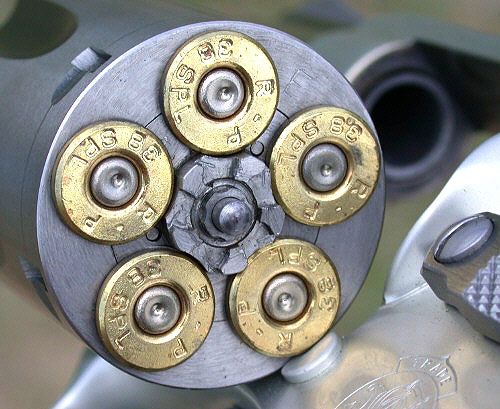 The first order of business was to fire five rounds and check primer strikes. These seem reasonably well centered and impact is sufficient for reliable ignition. As this gun as the original mainspring, light primer strikes were really never a concern.
The first order of business was to fire five rounds and check primer strikes. These seem reasonably well centered and impact is sufficient for reliable ignition. As this gun as the original mainspring, light primer strikes were really never a concern.
I then fired 10 shots at a slow pace to get "the feel" of this particular revolver. There was nothing remarkable or different so I began shooting to see how well this example of the Model 642 performed and whether or not it would remain in my collection.
Firing was done no farther than 15 yards today and that was done seated, using a two-hand hold, and in slow-fire. My wrists were supported. It is understood that this genre of revolver is not intended for precise target work but it is important to me that my personal handguns have their sights regulated such that POA is at least close to POI at the ranges that the weapon is envisioned being used at.
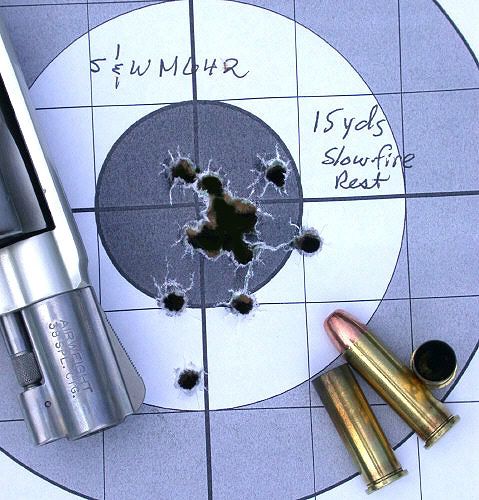 The size of this group is due more to human error than either mechanical error or the combination of ammunition and gun.
The size of this group is due more to human error than either mechanical error or the combination of ammunition and gun.
The rest of the shooting was done at 10 yards and was done standing with a two-hand hold. I did not have time to chronograph ammunition from this particular gun today and did not do any one-handed shooting even though that is normally part of my regular "work out" with the J-frame snub.
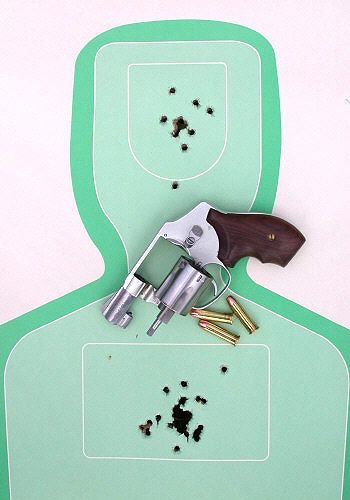 These shots were fired mostly in controlled pairs with a few "failure to stop" drills thrown in. Distance was ten yards and the little gun did its part when I did mine.
These shots were fired mostly in controlled pairs with a few "failure to stop" drills thrown in. Distance was ten yards and the little gun did its part when I did mine.
For those interested, here is a related article on practicing with the snub .38 for self-protection:
http://www.hipowersandhandguns.com/Maki ... 20Work.htm
I only used three different factory loads for this initial run with the Model 641:
Remington 130-gr. FMJ
Federal 125-gr. Nyclad Hollow Point (standard pressure)
Remington 158-gr. LSWCHP +P
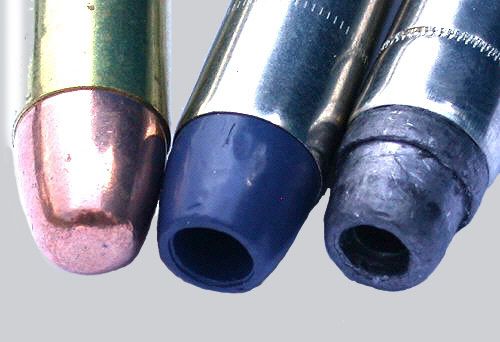 These are the three loads tried in the Model 642. All are factory with one being +P.
These are the three loads tried in the Model 642. All are factory with one being +P.
Average velocities for these rounds is normally around 800 ft/sec for the first, 850 to about 890 ft/sec for the second, depending upon the ammunition/gun combination in this barrel length, and 800 to about 830 ft/sec for the last load, again depending on how the particular lot of ammo works in a specific snub. In the future I'll obtain chronograph data from this particular snub.
At ten yards I fired several sets of controlled pairs at COM, working on a smooth double-action pull as soon as I could get it without jerking the trigger and as quickly as I could obtain a flash sight picture.
At fifteen yards I fired for group using the Remington 125-gr. FMJ and then fired a group at the same distance using some Federal 125-gr. Nyclads and shot the same target with the 158-gr. LSWCHP +P ammunition to see any divergence in points of impact.
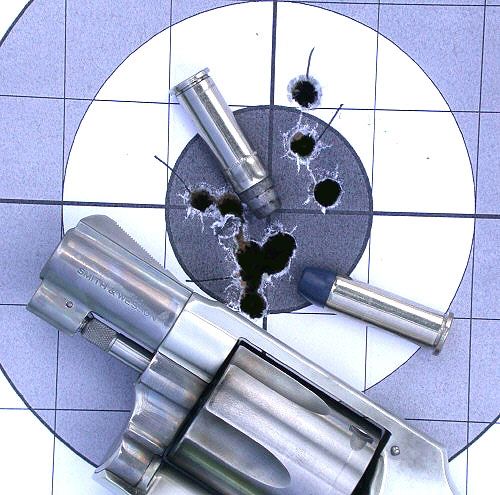 The Remington 158-gr. LSWCHP +P and the 125-gr. Nyclads hit had roughly the same POI but the former were a bit more spread out than the latter and seemed to hit just a bit higher. For all practical purposes that most snubs will be used for it can be said that the groups overlap.
The Remington 158-gr. LSWCHP +P and the 125-gr. Nyclads hit had roughly the same POI but the former were a bit more spread out than the latter and seemed to hit just a bit higher. For all practical purposes that most snubs will be used for it can be said that the groups overlap.
I also fired a 5 falling plates as fast as I could make the shot and repeated it five times.
 A row of 5 falling plates was shot with the little revolver. I believe that reactive targets help us maintain sight picture when we really want to see what the target is doing.
A row of 5 falling plates was shot with the little revolver. I believe that reactive targets help us maintain sight picture when we really want to see what the target is doing.
There were no failures to fire and the trigger pull remained constant, first shot to last. It is smooth but just a bit heavy. I will shoot this gun considerably more before having any possible trigger work done. The cylinder did not bind and case ejection was not "sticky." As is the case on any of these shorties, the ejector rod is not long enough to allow for full length ejection but it worked smoothly enough; a quick, sharp press or smack kicked the fired cases out nicely.
It should come as no surprise that it is hot in Texas in the summer. My hands were pretty sweaty within a few minutes but the smooth Eagle Secret Service stocks did not slip. I had really wondered if they might and such concerns are why my "serious" handguns almost always have checkered stocks at the least. I admit being surprised that such was not the case in this instance.
The most pleasant surprise of the day was that the POA almost exactly matches POI at least with the ammo used today out to about 15 yards. In fact, it is closer than on my 24/7 gun, a Model 642-1. (That one hits just a bit to the right.)
In short, the gun worked fine and it will be a keeper.
Best.








